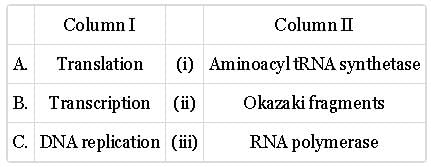Test: Translation (NCERT) - NEET MCQ
10 Questions MCQ Test - Test: Translation (NCERT)
Match column with column II and select the correct option from the given codes.


What would happen, if in a gene encoding a polypeptide of 50 amino acids, 25th codon (UAU) is mutated to UAA?
During translation, activated amino acids get linked to (RNA). This process is commonly called as
Which RNA carries the amino acids from the amino acid pool to mRNA during protein synthesis?
Choose the correct answer from the alternatives given :
Direction : Read the sequence of nucleotides in the given segment of mRNA and the respective amino acid sequence in the polypeptide chain.

Polypeptide Met-Phe-Met-Pro-Val-Ser
Which codons respectively code for proline and valine amino acids in the given polypeptide chain, respectively?

What is the process of activation of amino acids in the presence of ATP and its linkage to their cognate tRNA known as?
In a mRNA molecule, untranslated regions (UTRs) are present at
Given below are the steps of protein synthesis. Arrange them in. correct sequence and select the correct option.
(i) Codon-anticodon reaction between mRNA and aminoacyl tRNA complex.
(ii) Attachment of mRNA and smaller sub-unit of ribosome.
(iii) Charging or aminoacylation of tRNA.
(iv) Attachment of larger sub unit of ribosome to the mRNA-tRNAMet complex.
(v) Linking of adjacent amino acids.
(vi) Formation of polypeptide chain.
The difference(s) between mRNA and tRNA is/are that:
(i) mRNA has more elaborate 3 - dimensional structure due to extensive base - pairing
(ii) tRNA has more elaborate 3 - dimensional structure due to extensive pairing
(iii) tRNA is usually smaller than mRNA
(iv) mRNA bears anticodon but tRNA has codons



















